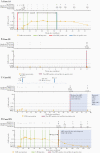Characterization of Human Immunodeficiency Virus (HIV) Infections in Women Who Received Injectable Cabotegravir or Tenofovir Disoproxil Fumarate/Emtricitabine for HIV Prevention: HPTN 084
- PMID: 35301540
- PMCID: PMC9113509
- DOI: 10.1093/infdis/jiab576
Characterization of Human Immunodeficiency Virus (HIV) Infections in Women Who Received Injectable Cabotegravir or Tenofovir Disoproxil Fumarate/Emtricitabine for HIV Prevention: HPTN 084
Abstract
Background: HIV Prevention Trials Network 084 demonstrated that long-acting injectable cabotegravir (CAB) was superior to daily oral tenofovir (TFV) disoproxil fumarate (TDF)/emtricitabine (FTC) for preventing human immunodeficiency virus (HIV) infection in sub-Saharan African women. This report describes HIV infections that occurred in the trial before unblinding.
Methods: Testing was performed using HIV diagnostic assays, viral load testing, a single-copy RNA assay, and HIV genotyping. Plasma CAB, plasma TFV, and intraerythrocytic TFV-diphosphate concentrations were determined by liquid chromatography-tandem mass spectrometry.
Results: Forty HIV infections were identified (CAB arm, 1 baseline infection, 3 incident infections; TDF/FTC arm, 36 incident infections). The incident infections in the CAB arm included 2 with no recent drug exposure and no CAB injections and 1 with delayed injections; in 35 of 36 cases in the TDF/FTC arm, drug concentrations indicated low or no adherence. None of the cases had CAB resistance. Nine women in the TDF/FTC arm had nonnucleoside reverse-transcriptase inhibitor resistance; 1 had the nucleoside reverse-transcriptase inhibitor resistance mutation, M184V.
Conclusions: Almost all incident HIV infections occurred in the setting of unquantifiable or low drug concentrations. CAB resistance was not detected. Transmitted nonnucleoside reverse-transcriptase inhibitor resistance was common; 1 woman may have acquired nucleoside reverse-transcriptase inhibitor resistance from study drug exposure.
Keywords: Africa; HIV; HPTN 084; TDF/FTC; cabotegravir; injectable; long-acting; preexposure prophylaxis; prevention; women.
© The Author(s) 2022. Published by Oxford University Press for the Infectious Diseases Society of America. All rights reserved. For permissions, e-mail: journals.permissions@oup.com.
Figures



References
-
- Riddell J, Amico KR, Mayer KH.. HIV preexposure prophylaxis: a review. JAMA 2018; 319:1261–8. - PubMed
-
- Gulick RM, Flexner C.. Long-acting HIV drugs for treatment and prevention. Annu Rev Med 2019; 70:137–50. - PubMed
-
- US Food and Drug Administration. FDA approves first extended-release, injectable drug regimen for adults living with HIV. https://www.fda.gov/news-events/press-announcements/fda-approves-first-e.... Accessed 7 May 2021.
Publication types
MeSH terms
Substances
Grants and funding
LinkOut - more resources
Full Text Sources
Medical

